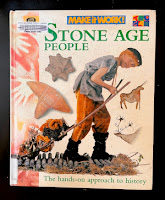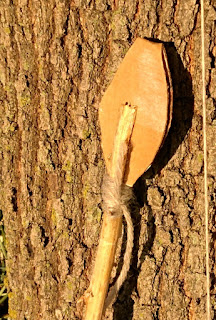This is part of a series where I share about our Story of the World lessons. Even if you don't use SOTW, I think you'll enjoy the ancient history activities shared (especially if you are studying the Stone Age or Pre-history).
Since my son has a short attention span we did each sub-chapter of Story of the World on a separate day, and sometimes even broke that up into small parts. I decided to break up "The Earliest People - The First Nomads" into two parts, then did a special activity on the third day. We used Stone Age People, a book we found at our library, to supply the pictures Story of the World was lacking.

Stone Age People is part of the Make It Work Series, which has a lot of crafts and projects kids can do related to the time period, as well as a lot of great historical information. We mainly used it for the pictures, but might do some of the crafts later.
It does have info about human evolution in a few of the beginning pages. If that's something you want to skip, it's easy to when using the book piecemeal as a backdrop for the Story of the World reading, as we did.
DAY 1
On the first day, we read the first four paragraphs of the section "The First Nomads" in Story of the World. We were doing this as part of "play school" today (I teach a lot of my lessons pretending to be a dinosaur teacher, and my son pretending to be a number of toy students in a pint size classroom...it works for us). So some of the other toy "students" answered the questions along with my son. My son said that he slept in the same place every night, but his toy "Lion" slept in a different place every night...we even talked about why that might be (ie, because lions needed to follow the prey). That made a great segue to paragraph two.
At paragraph three I pulled out Stone Age People and turned to the page where they have a scene with hunter gatherers that made a perfect illustration for what we were reading. As we read the paragraph I asked him to find some of the things it talked about, like people gathering berries and hunting.
 Then we turned to the next page, where they had pictures of various types of homes and shelters, and I asked him which ones you could take with you or set up quickly if you were traveling around, which ones you could build a fire in, and which ones would be nicer when it was cold vs. when it was hot. Then I read the last paragraph and we looked at the cave pictures later on in Stone Age People (pg 36 - 37).
Then we turned to the next page, where they had pictures of various types of homes and shelters, and I asked him which ones you could take with you or set up quickly if you were traveling around, which ones you could build a fire in, and which ones would be nicer when it was cold vs. when it was hot. Then I read the last paragraph and we looked at the cave pictures later on in Stone Age People (pg 36 - 37).
Later we read The First Dog by Jan Brett, a beautifully illustrated story about a boy and a wolf who befriended him, and became the first dog.
Day 2
On the second day we read the story of Tarak and her brother in Story of the World , looking again at page 16 - 17 of Stone Age People. Also, the older version of Story of the World actually had a nice illustration of Tarak catching lizards, one of the few illustrations I think is better in the older, un-revised version.
Afterwords we started a book about Tarak and her family using a cave printable I made (free to download).
You can see she made handprints on the cave wall, like some of the cave art we had looked at, and in this story Tarak had a wolf like the story of the The First Dog (and the wolf had a pup in his version). The green thing to the left of Tarak is one of the lizards she caught.
EXTRA ACTIVITY - ROCK ART
We didn't do this while studying this chapter, but later we did a rock art activity when we were learning about the prehistoric artwork in the Lascaux caves, and it's something that would fit in nicely here.
To pique interest you can watch a short video about these caves here, or take a 365 degree virtual tour here (on the Lascaux FB page another cool but shorter interactive Pano). I also suggest googling pictographs in your local area or state, and sharing any pictures you find with your kids. You might even find a site you can visit.
First, I collected rocks to paint on. Because of time we just used regular paint...but I tried to match the colors to those used in the Lascaux cave, and we talked about why they used those colors and what materials they would have made their colors with. You can also make your own paint using minerals or gathered material, which would be really fun. For older kids, this article has more about prehistoric paints, and they have some links toward the bottom to paint-making activities that look more at the chemistry of making paints.
Here's our rock art. Our son really enjoyed this.
DAY 3 - Hunter Gatherer Hike
For our activity we decided to do a "hunter gatherer" trek on a nearby hiking trail. I invited another homeschooling family to come along, and discovered that they were doing Story of the World too!
I made some really simple toy bows and arrows and spears. SERIOUSLY SIMPLE. Those are branches from our tree and some weed stalks (we have some really vigorous roadside weeds here in Texas...I suggest wild goldenrod if it lives near you). The string is just brown yarn, and the tips are cardboard.
The bows actually sort of worked (they could shoot the "arrows" a few feet...not fast enough to hurt anyone, but far enough to be "cool."
I attached the tips of the spears by splitting the top of the branches and inserting the cardboard ...then binding yarn around to make it tighter. If I had thought better I would have cut a "shaft" on the tips and wrapped the yarn around that. They might have stayed on longer that way....but they worked well enough. The kids were happy about their weapons.
I've seen some other bow versions that may shoot a little better made from bamboo or PVC (And I love the idea of an eraser capped arrows). If you have older kids and want to try your hand at making a really realistic primitive arrow (with bone), there's a nice tutorial here.
After making our arrows we headed for a nature trail. We didn't know beforehand that the trail had been decorated with funny scarecrows for Halloween, so we ad-libbed and wondered out-loud who had made these strange statues, and what they might mean.
One of the kids found snails and we talked about how that would be great in our soup that night (No, we didn't really eat them...no wild escargot for us!).
We stopped for a break of seeds and berries my friend had brought (um..."gathered earlier"), and then hiked down to a small stream. I had hoped to find animal prints near the muddy bank...we did find one dog print (um...I mean..."wolf" print), and lots of tiny fish we pretended to catch for supper. AND, my friend found an edible plant, purslane, which we tried, with mixed reactions (her daughter hated it so much she drank her whole water bottle to wash away the taste away...but I liked it. It sort of tastes like lettuce.).
So, if you are trying this, it might be fun to see if your library has a book on common editable plants to familiarize yourself with beforehand (in case you don't have a friend with who just happens to know of some). Be careful...do your research well, but you should be safe with common, easily recognizable plants like dandelion (purslane actually has a poisonous doppelganger, spotter spurge, so make sure you study up on look alikes and know how to tell the difference before sampling). Also, you want to make sure to wash anything well before you eat it (you can rinse with a water bottle), and avoid collecting anything where pesticides or herbicides might have been sprayed (our purslane was found well off the beaten path so should have been safe from those).
Overall the nomad hike was a great success! The kids enjoyed it and it really made what they had read come alive.
RESOURSES/SUPPLIES WE USED:
During Reading:
Stone Age People (for illustrations)
Supplemental Reading:
Rock Painting Activity:
- Lascaux Cave video
- Virtual Tour
- Interactive Pano
- Rocks
- Paint (or gather things to make your own paint)
- Paintbrushes
Cave Book Activity:
- Cave Book Printable
- Crayons
- A stapler
Nomad Hike Activity:
- Straight Branches (and something to cut them with)
- Yarn or Twine
- Cardboard
- Water plus snacks for the hike (berries, dried fruit, nuts, jerky:things available in the stone age)
LINKING UP AT
Field Trip Friday
Hip Homeschool Moms
Dear Homeschooler Bookshelf
Country Kids at Coombe Mill
Homeschool Highlights
Throwback Thursday






















